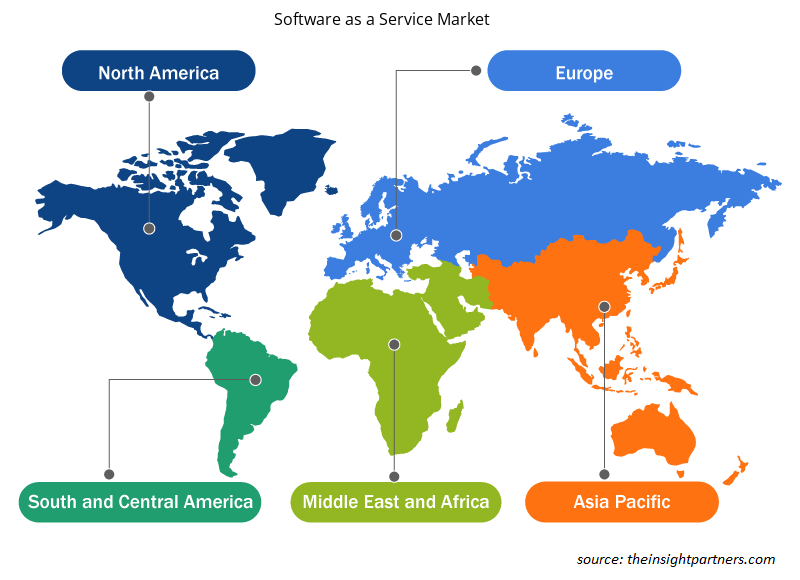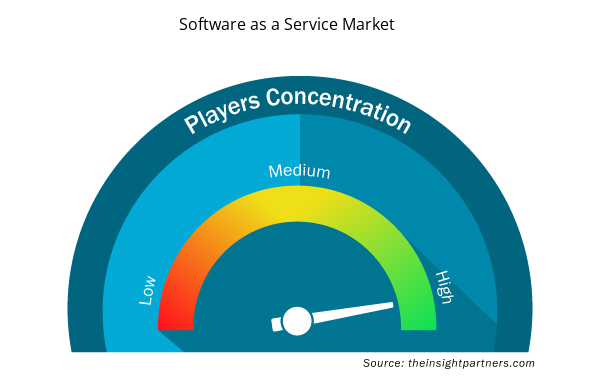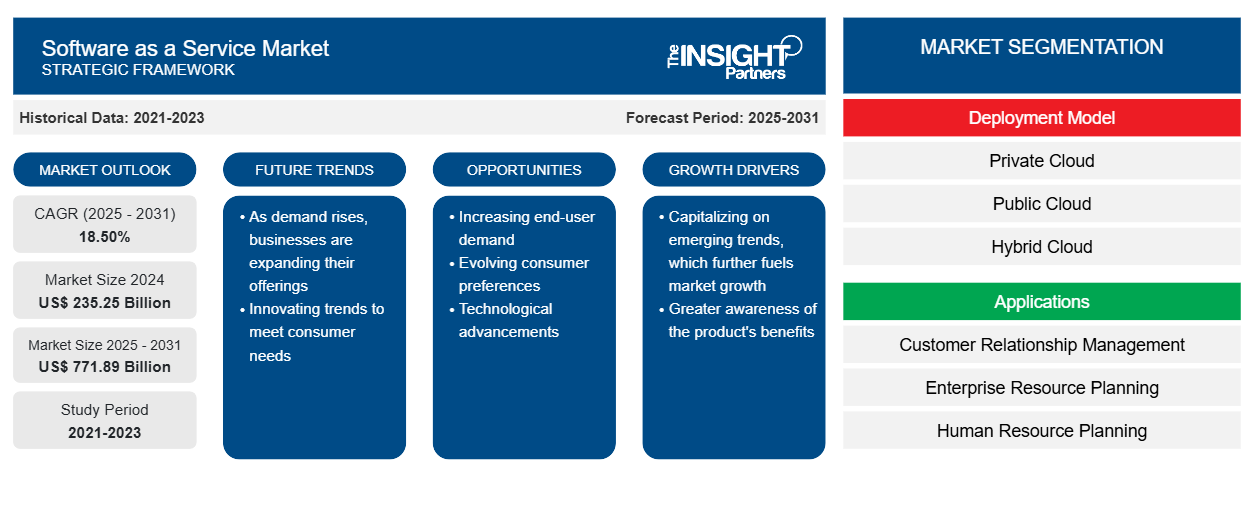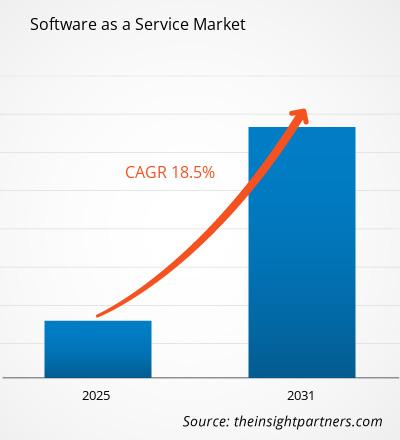Si prevede che il mercato del software come servizio crescerà da 167,53 miliardi di dollari nel 2022 a 462,94 miliardi di dollari entro il 2031; si stima che crescerà a un CAGR del 18,5% dal 2022 al 2031.
Le applicazioni SaaS hanno il potenziale per fornire servizi alle piccole, medie e grandi imprese in modo efficiente. Le organizzazioni odierne stanno crescendo rapidamente e richiedono che le operazioni si espandano in base alla domanda. Con la facilità di scalabilità offerta dal modello SaaS, molte organizzazioni sembrano adottare il modello SaaS per le loro varie operazioni, che si tratti di gestire la loro infrastruttura IT, la gestione finanziaria, la gestione del capitale umano, il monitoraggio delle risorse o qualsiasi altro dominio utile. L'adozione di una struttura modulare in grado di scalare l'infrastruttura IT, l'archiviazione, l'elaborazione, la struttura e la virtualizzazione in un'unica architettura sta venendo rapidamente adottata in tutto il mondo, offrendo opportunità commerciali redditizie ai player del mercato globale del software come servizio . La flessibilità offerta dai modelli SaaS offre un vantaggio competitivo alle aziende adattandosi rapidamente alle richieste dei clienti e apportando le modifiche necessarie alle operazioni in modo efficiente. L'elevata efficienza è diventata un prerequisito per le aziende leader odierne e l'implementazione dei modelli SaaS offre loro il potere di essere flessibili ed efficienti. Gli strumenti utilizzati dai fornitori SaaS sono in genere più solidi e aggiornati di quelli disponibili per la maggior parte delle organizzazioni locali. Questi fattori influenzano la crescita del mercato del software come servizio.
Inoltre, i fornitori SaaS utilizzano server ridondanti per eseguire il backup dei dati. Pertanto, in caso di malfunzionamento nel cloud, gli utenti vengono automaticamente reindirizzati a un server di backup senza problemi di prestazioni. Inoltre, i fornitori SaaS eseguono regolarmente backup dei dati. Poiché esiste una sola versione del software, in genere più risorse del fornitore vengono indirizzate all'identificazione di problemi/bug e alle relative patch/correzioni necessarie per risolvere tali problemi. Questi fattori stanno ulteriormente spingendo la crescita del mercato del software come servizio.
SaaS è una tecnologia avanzata che trasforma i tradizionali sistemi software on-premise in una moderna soluzione basata sul cloud a livello globale. Oltre a ridurre gli sforzi di esecuzione di un processo e di installazione e acquisto di software, aiuta anche un'organizzazione a ridurre al minimo i costi e massimizzare i ricavi. Di conseguenza, le organizzazioni private in tutto il mondo hanno compreso il potenziale dietro questi servizi e hanno ideato servizi basati sul cloud. Questi fattori stanno stimolando la crescita del mercato.
Personalizza questo report in base alle tue esigenze
Riceverai la personalizzazione gratuita di qualsiasi report, comprese parti di questo report, o analisi a livello nazionale, pacchetto dati Excel, oltre a usufruire di grandi offerte e sconti per start-up e università
- Scopri le principali tendenze di mercato in questo rapporto.Questo campione GRATUITO includerà analisi di dati che spaziano dalle tendenze di mercato alle stime e alle previsioni.
Con le crescenti preoccupazioni per la sicurezza e la privacy dei dati, è stato sviluppato un modello di distribuzione cloud privato, ma si è rivelato molto costoso. Tutti i dati delle organizzazioni non possono essere critici per la missione e sensibili. Vari tipi di dati richiedono diversi livelli di sicurezza. La flessibilità di archiviazione di dati meno critici su cloud pubblico mentre i dati critici per la missione su cloud ibrido lo rendono altamente attraente per le organizzazioni da adottare. Il settore bancario che deve archiviare grandi quantità di dati sensibili è il segmento aziendale che ha tratto i maggiori benefici dall'introduzione del modello di distribuzione cloud ibrido. Si prevede quindi che il modello cloud ibrido crescerà a un ritmo rapido durante il periodo di previsione, offrendo opportunità di crescita redditizie alla quota di mercato del software ibrido come servizio.
Analisi regionale del mercato del software come servizio
Da una prospettiva regionale, il Nord America ha detenuto la quota maggiore del mercato globale del software come servizio nel 2021. Con la crescente domanda dei clienti di prodotti e servizi di alta qualità, le aziende nordamericane stanno costantemente innovando per servire i propri clienti nel miglior modo possibile. Ciò sta aumentando la domanda di soluzioni come CRM ed ERP. Inoltre, la presenza di fornitori SaaS come Microsoft Corporation, Amazon Web Services, Symantec Corporation, IBM, ORACLE, ADP LLC, Workday e Google in tutta la regione sta ulteriormente contribuendo alla rapida crescita del mercato.
Approfondimenti regionali sul mercato del software come servizio
Le tendenze regionali e i fattori che influenzano il mercato del software come servizio durante il periodo di previsione sono stati ampiamente spiegati dagli analisti di Insight Partners. Questa sezione discute anche i segmenti e la geografia del mercato del software come servizio in Nord America, Europa, Asia Pacifico, Medio Oriente e Africa e America centrale e meridionale.

- Ottieni i dati specifici regionali per il mercato del software come servizio
Ambito del rapporto sul mercato del software come servizio
| Attributo del report | Dettagli |
|---|---|
| Dimensioni del mercato nel 2023 | 198,52 miliardi di dollari USA |
| Dimensioni del mercato entro il 2031 | 771,89 miliardi di dollari USA |
| CAGR globale (2023-2031) | 18,50% |
| Dati storici | 2021-2022 |
| Periodo di previsione | 2024-2031 |
| Segmenti coperti | Per modello di distribuzione
|
| Regioni e Paesi coperti | America del Nord
|
| Leader di mercato e profili aziendali chiave |
|
Densità degli attori del mercato: comprendere il suo impatto sulle dinamiche aziendali
Il mercato del Software as a Service Market sta crescendo rapidamente, spinto dalla crescente domanda degli utenti finali dovuta a fattori quali l'evoluzione delle preferenze dei consumatori, i progressi tecnologici e una maggiore consapevolezza dei vantaggi del prodotto. Con l'aumento della domanda, le aziende stanno ampliando le loro offerte, innovando per soddisfare le esigenze dei consumatori e capitalizzando sulle tendenze emergenti, il che alimenta ulteriormente la crescita del mercato.
La densità degli operatori di mercato si riferisce alla distribuzione di aziende o società che operano in un particolare mercato o settore. Indica quanti concorrenti (operatori di mercato) sono presenti in un dato spazio di mercato in relazione alle sue dimensioni o al valore di mercato totale.
Le principali aziende che operano nel mercato del Software as a Service sono:
- Google, Inc.
- Società Oracle
- Amazon.com, Inc.
- Salesforce.com, Inc.
- Fujitsu Ltd.
Disclaimer : le aziende elencate sopra non sono classificate secondo un ordine particolare.

- Ottieni una panoramica dei principali attori del mercato del software come servizio
Approfondimenti di mercato – Mercato del software come servizio
Approfondimenti basati sulle applicazioni
In base all'applicazione, il mercato del software come servizio è segmentato in gestione delle relazioni con i clienti (CRM), pianificazione delle risorse aziendali (ERP), pianificazione delle risorse umane (HRP), gestione della catena di fornitura (SCM) e altri. Il segmento CRM ha rappresentato la quota maggiore del mercato globale del software come servizio nel 2021. Con i suoi numerosi vantaggi, SaaS CRM ha cambiato con successo la percezione delle organizzazioni su come vengono utilizzati e controllati i sistemi software front-office. In particolare per CRM, le applicazioni SaaS offrono vari vantaggi come infrastrutture best-in-place senza la necessità di spese in conto capitale, tempi di implementazione e integrazione inferiori con i sistemi esistenti, aggiornamenti software senza alcun collo di bottiglia significativo, tempi di attività del sistema costanti e personale 24 ore su 24, 7 giorni su 7. Tiene traccia e gestisce attivamente le informazioni dei clienti, acquisisce le e-mail dei clienti, semplifica le attività ripetitive e fornisce approfondimenti e raccomandazioni immediati. Man mano che l'azienda cresce, CRM aiuta a personalizzare le funzioni. Secondo Salesforce, uno dei principali fornitori di CRM, le soluzioni aiutano in media i loro clienti a migliorare le vendite del 30% e si registra un aumento del 40% nella soddisfazione del cliente. Questi fattori contribuiscono ulteriormente alla crescita del segmento.
Gli operatori che operano nel mercato del software come servizio si concentrano principalmente sullo sviluppo di prodotti avanzati ed efficienti.
- Nel dicembre 2022, Microsoft Corporation ha annunciato la sua partnership decennale con LSEG per offrire soluzioni di analisi dei dati e infrastrutture cloud.
- A novembre 2022, Shadow ha annunciato il lancio del suo nuovo servizio di archiviazione cloud denominato Shadow Drive.
Il mercato del software come servizio è segmentato in cinque regioni principali: Nord America, Europa, Asia Pacifico (APAC), Medio Oriente e Africa e Sud America. Nel 2021, il Nord America ha guidato il mercato con una quota di fatturato sostanziale, seguito dall'Europa. Inoltre, si prevede che l'Asia Pacifico registrerà il CAGR più elevato nel mercato del software come servizio dal 2022 al 2031.
I principali attori del mercato globale del software come servizio includono ADP LLC, Amazon.com Inc, Google Inc, IBM Corporation, Microsoft Corporation, Oracle Corporation, Salesforce.com Inc, SAP SE, Fujitsu Limited e Workday Inc.
- Analisi storica (2 anni), anno base, previsione (7 anni) con CAGR
- Analisi PEST e SWOT
- Valore/volume delle dimensioni del mercato - Globale, regionale, nazionale
- Industria e panorama competitivo
- Set di dati Excel



Report Coverage
Revenue forecast, Company Analysis, Industry landscape, Growth factors, and Trends

Segment Covered
This text is related
to segments covered.

Regional Scope
North America, Europe, Asia Pacific, Middle East & Africa, South & Central America

Country Scope
This text is related
to country scope.
Trends and growth analysis reports related to Technology, Media and Telecommunications : READ MORE..
The List of Companies - Software as a Service (SaaS) Market
- Google, Inc.
- Oracle Corporation
- Amazon.com, Inc.
- Salesforce.com, Inc.
- Fujitsu Ltd.
- Workday, Inc.
- ADP, LLC
- IBM Corporation
- SAP SE
- Microsoft Corporation
The Insight Partners performs research in 4 major stages: Data Collection & Secondary Research, Primary Research, Data Analysis and Data Triangulation & Final Review.
- Data Collection and Secondary Research:
As a market research and consulting firm operating from a decade, we have published and advised several client across the globe. First step for any study will start with an assessment of currently available data and insights from existing reports. Further, historical and current market information is collected from Investor Presentations, Annual Reports, SEC Filings, etc., and other information related to company’s performance and market positioning are gathered from Paid Databases (Factiva, Hoovers, and Reuters) and various other publications available in public domain.
Several associations trade associates, technical forums, institutes, societies and organization are accessed to gain technical as well as market related insights through their publications such as research papers, blogs and press releases related to the studies are referred to get cues about the market. Further, white papers, journals, magazines, and other news articles published in last 3 years are scrutinized and analyzed to understand the current market trends.
- Primary Research:
The primarily interview analysis comprise of data obtained from industry participants interview and answers to survey questions gathered by in-house primary team.
For primary research, interviews are conducted with industry experts/CEOs/Marketing Managers/VPs/Subject Matter Experts from both demand and supply side to get a 360-degree view of the market. The primary team conducts several interviews based on the complexity of the markets to understand the various market trends and dynamics which makes research more credible and precise.
A typical research interview fulfils the following functions:
- Provides first-hand information on the market size, market trends, growth trends, competitive landscape, and outlook
- Validates and strengthens in-house secondary research findings
- Develops the analysis team’s expertise and market understanding
Primary research involves email interactions and telephone interviews for each market, category, segment, and sub-segment across geographies. The participants who typically take part in such a process include, but are not limited to:
- Industry participants: VPs, business development managers, market intelligence managers and national sales managers
- Outside experts: Valuation experts, research analysts and key opinion leaders specializing in the electronics and semiconductor industry.
Below is the breakup of our primary respondents by company, designation, and region:

Once we receive the confirmation from primary research sources or primary respondents, we finalize the base year market estimation and forecast the data as per the macroeconomic and microeconomic factors assessed during data collection.
- Data Analysis:
Once data is validated through both secondary as well as primary respondents, we finalize the market estimations by hypothesis formulation and factor analysis at regional and country level.
- Macro-Economic Factor Analysis:
We analyse macroeconomic indicators such the gross domestic product (GDP), increase in the demand for goods and services across industries, technological advancement, regional economic growth, governmental policies, the influence of COVID-19, PEST analysis, and other aspects. This analysis aids in setting benchmarks for various nations/regions and approximating market splits. Additionally, the general trend of the aforementioned components aid in determining the market's development possibilities.
- Country Level Data:
Various factors that are especially aligned to the country are taken into account to determine the market size for a certain area and country, including the presence of vendors, such as headquarters and offices, the country's GDP, demand patterns, and industry growth. To comprehend the market dynamics for the nation, a number of growth variables, inhibitors, application areas, and current market trends are researched. The aforementioned elements aid in determining the country's overall market's growth potential.
- Company Profile:
The “Table of Contents” is formulated by listing and analyzing more than 25 - 30 companies operating in the market ecosystem across geographies. However, we profile only 10 companies as a standard practice in our syndicate reports. These 10 companies comprise leading, emerging, and regional players. Nonetheless, our analysis is not restricted to the 10 listed companies, we also analyze other companies present in the market to develop a holistic view and understand the prevailing trends. The “Company Profiles” section in the report covers key facts, business description, products & services, financial information, SWOT analysis, and key developments. The financial information presented is extracted from the annual reports and official documents of the publicly listed companies. Upon collecting the information for the sections of respective companies, we verify them via various primary sources and then compile the data in respective company profiles. The company level information helps us in deriving the base number as well as in forecasting the market size.
- Developing Base Number:
Aggregation of sales statistics (2020-2022) and macro-economic factor, and other secondary and primary research insights are utilized to arrive at base number and related market shares for 2022. The data gaps are identified in this step and relevant market data is analyzed, collected from paid primary interviews or databases. On finalizing the base year market size, forecasts are developed on the basis of macro-economic, industry and market growth factors and company level analysis.
- Data Triangulation and Final Review:
The market findings and base year market size calculations are validated from supply as well as demand side. Demand side validations are based on macro-economic factor analysis and benchmarks for respective regions and countries. In case of supply side validations, revenues of major companies are estimated (in case not available) based on industry benchmark, approximate number of employees, product portfolio, and primary interviews revenues are gathered. Further revenue from target product/service segment is assessed to avoid overshooting of market statistics. In case of heavy deviations between supply and demand side values, all thes steps are repeated to achieve synchronization.
We follow an iterative model, wherein we share our research findings with Subject Matter Experts (SME’s) and Key Opinion Leaders (KOLs) until consensus view of the market is not formulated – this model negates any drastic deviation in the opinions of experts. Only validated and universally acceptable research findings are quoted in our reports.
We have important check points that we use to validate our research findings – which we call – data triangulation, where we validate the information, we generate from secondary sources with primary interviews and then we re-validate with our internal data bases and Subject matter experts. This comprehensive model enables us to deliver high quality, reliable data in shortest possible time.


 Ottieni un campione gratuito per questo repot
Ottieni un campione gratuito per questo repot